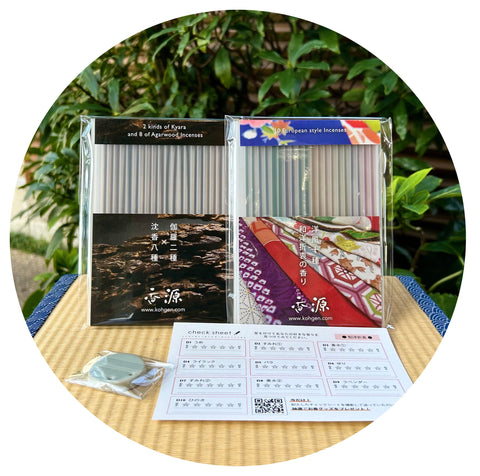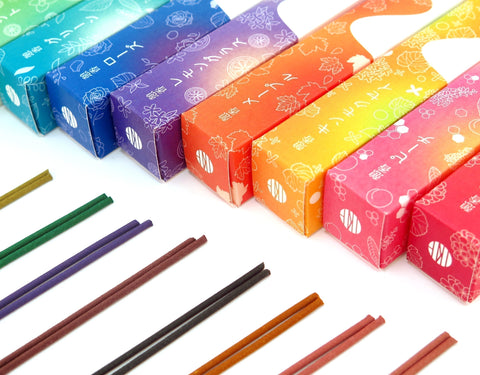
How many types of incense fragrances are there?
What kind of scent does traditional Japanese incense have?
Here, we explain the fragrances found in Japanese-made incense.
3 Steps to Fall in Love with Incense

About Fragrant Woods and Ingredients
Traditional Japanese incense often uses fragrant woods known as fragrant wood scents.
The raw materials include three types of fragrant woods: Kyara, Jinkoh (Aloeswood), and Byakudan (Sandalwood).
Fragrant woods are trees that naturally emit fragrance. Their existence is recorded in Japan's oldest historical text, the Nihon Shoki, and have been prized for over a thousand years as valuable incense materials.
The three main fragrant woods used in Japanese incense are these. Among them, Kyara is extremely expensive, costing tens of thousands of yen per gram.
Compared to Kyara, Jinkoh and Byakudan are more affordable but remain precious ingredients.
Therefore, fragrant wood incense is generally priced higher than fragrance-type incense.

Kyara
Kyara is the ultimate fragrant wood, described by top perfumers as "a scent created by the gods, impossible for humans to reproduce."
The resin in the wood produces an indescribably pleasant fragrance that has captivated historical figures such as Oda Nobunaga and Emperor Meiji.
Normally, fragrant wood is enjoyed when warmed, but Kyara emits a wonderful scent even without heating due to its high resin content.
Its availability is increasingly limited, and its price continues to soar. Kyara incense is the flagship product of many incense makers.

Jinkoh (Aloeswood)
The name Jinkoh derives from "sinking fragrant wood" (meaning it sinks in water due to its density).
It forms when tropical trees in Southeast Asia of the Thymelaeaceae family develop resin in response to injury, which ages over a long period to produce its scent.
Like Kyara, it is a precious material.
Its fragrance and value vary by origin and aging, with distinctive scents from Vietnam, Indonesia, Malaysia, and Cambodia.
Due to high demand, high-quality Jinko has become increasingly rare.

Byakudan (Sandalwood)
Byakudan is the most commonly used fragrant wood in incense and fragrance bases.
Even if you don't know the name, you might be familiar with its friendly scent.
The fragrant part is the heartwood and roots, requiring over 20 years of aging after harvesting.
It emits fragrance at room temperature and is also used in sculptures and fans.
Today, only small chips are available, making it a valuable material.
Main production areas include India, Indonesia, and Fiji, each with distinctive scents. Byakudan has a cool, sweet aroma different from Kyara and Jinko.
For those who want to try fragrant wood incense

20 Incense Variety Set
20 Incense Variety Set
A total of 40 sticks (2 each) with 2 Kyara scents, 8 Jinkoh scents, and 10 fragrance-type scents. Comes with a scent checklist, answer sheet, and incense holder—perfect for first-timers!
About Fragrance Types
Classifying incense by main scent such as Kyara, Jinkoh, Byakudan, or floral incense is relatively easy, but that one word cannot fully express all the fragrance nuances. This depth and interest are what make incense so fascinating.
The same classification can have different scent personalities depending on raw materials, blending ratios, or manufacturers.
For example, just saying "Kyara incense" doesn’t tell you how "A’s Kyara" differs from "B’s Kyara," so you can’t really compare them.
At Kohgen, to better convey fragrance impressions, we have established three fragrance categories beyond simple classification.
Fragrance types sometimes have subcategories, but some scents are unique and don’t require division.
- Traditional scents – Somewhat old-fashioned and calming. Evokes a Japanese atmosphere.
- Elegant scents – Bright, gorgeous, and light. Modern feel.
- Straight scents – The pure, main fragrance itself.
If you’ve used a "bright and elegant" scent but want something calmer next time, try a "traditional" scent.
Since there are many kinds of incense, if you’re unsure what to choose, please consult us.
We will recommend the perfect incense for you!
Fragrance Category Image
For example, even though we say "Byakudan incense" or "Lavender incense," the scent atmosphere varies by incense.


Non-Fragrant Wood Scents
Besides Japanese-style scents, incense includes floral, fragrance, green, coffee, and many other scents.
Various fragrances are developed daily to create these impressions.
Some worry about synthetic fragrances and their ingredients or health effects.
Japanese incense uses fragrances approved by the International Fragrance Association (IFRA), making them safer than some overseas products.
We occasionally receive inquiries about Indian incense, but Kohgen sticks to Japanese-made incense for these reasons.
Nowadays, scents not only include flowers like lavender and rose but also delicious drinks and fruits such as coffee, tea, peach, honey, and chocolate, all reproduced to enjoy in incense.
The greatest feature of fragrance-based incense is its wide variety and potential, distinct from fragrant wood incense.




